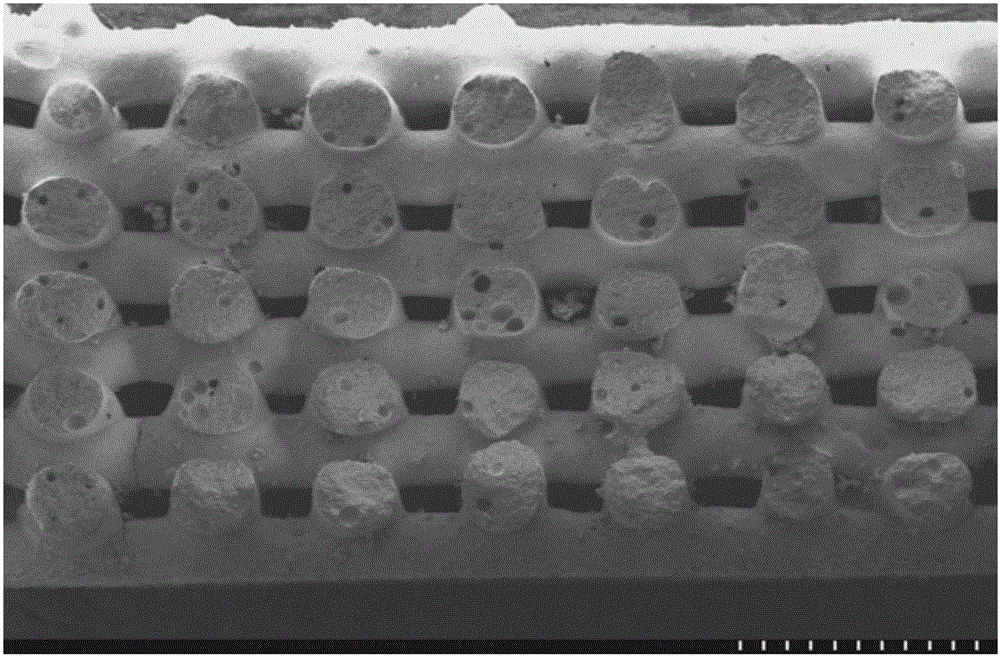Bioactive porous ceramic tubular bar material as well as preparation method and application thereof
A porous ceramic and bioactive technology, applied in the field of medical biomaterials, can solve the problems of slow degradation, and achieve the effects of promoting vascularization, excellent biological activity, cell migration and osteogenesis
- Summary
- Abstract
- Description
- Claims
- Application Information
AI Technical Summary
Problems solved by technology
Method used
Image
Examples
Embodiment 1
[0061] 1) Put the diopside powder into a ball mill and mill it for 6 hours, then sieve it to obtain an ultrafine powder with a particle size of less than 60 μm, and then stir and disperse the ultrafine powder at a solid-to-liquid mass ratio of 1:2 to a concentration of In 6% polyvinyl alcohol aqueous solution, a two-phase uniform paste is formed, and then the paste slurry is placed in the injection reservoir of the write-in 3D printer, and the shape of the honeycomb channel is set (as attached figure 1 ), the diameter of the central hole channel is 2.6mm, the diameter of the rod is 42mm, and the porosity is set to 24%, 50% and 84% respectively according to 50%, 30% and 20% of the length of the rod, start the printing equipment, press Carry out three-dimensional printing to form a tubular porous rod with an outer diameter and an inner diameter of 42mm and 2.6mm respectively, then dry the tubular porous rod at 60°C for 12 hours, and sinter at 1300°C for 4 hours to obtain a porous...
Embodiment 2
[0066] The preparation method is the same as in Example 1, the difference is that in step 1), the superfine powder is stirred and dispersed into the polyvinyl alcohol aqueous solution with a concentration of 3% at a solid-to-liquid mass ratio of 1:1, and 55% of the length of the rod is used. , 30% and 15% respectively set the porosity to 21%, 55% and 81%, start the printing equipment, press to perform three-dimensional printing, and form a tubular porous rod with an outer diameter and an inner diameter of 42mm and 11.2mm respectively, and obtain after sintering Diopside porous ceramic tubes with outer diameter and inner diameter of 40mm and 10mm respectively; the raw material composition for preparing the calcium magnesium silicate modification layer in step 2) is adjusted to: 0.1mol ethyl orthosilicate is dissolved in 1000ml deionized water , then add 1ml of nitric acid and stir for 15 minutes, then add 0.7mol calcium nitrate and 0.1mol magnesium nitrate, stir and hydrolyze fo...
Embodiment 3
[0068] The preparation method is the same as in Example 1, the difference being that the porosity is set to 35%, 50% and 65% respectively according to 65%, 20% and 15% of the rod length in step 1), and the calcium prepared in step 2) The raw material composition of the magnesium silicate modification layer is adjusted as follows: dissolve 0.40mol tetraethyl orthosilicate in 90ml deionized water, then add 2ml nitric acid and stir for 15 minutes, then add 0.4mol calcium nitrate and 0.016mol magnesium nitrate, at room temperature Stirring and hydrolysis for 60 minutes, aging for 24 hours, the mixed solution is converted into a hydrogel, the diopside porous ceramic tube prepared in step 1) is placed in the gel, and the negative pressure suction is impregnated, and the porous ceramic tubular rod is taken out, Then use vacuum filtration to suck out the excess gel in the pores, continue to age for 36 hours, dry at 95°C for 36 hours, calcinate at 950°C for 2 hours, and cool naturally. ...
PUM
| Property | Measurement | Unit |
|---|---|---|
| Thickness | aaaaa | aaaaa |
| Thickness | aaaaa | aaaaa |
| Thickness | aaaaa | aaaaa |
Abstract
Description
Claims
Application Information
 Login to View More
Login to View More - R&D
- Intellectual Property
- Life Sciences
- Materials
- Tech Scout
- Unparalleled Data Quality
- Higher Quality Content
- 60% Fewer Hallucinations
Browse by: Latest US Patents, China's latest patents, Technical Efficacy Thesaurus, Application Domain, Technology Topic, Popular Technical Reports.
© 2025 PatSnap. All rights reserved.Legal|Privacy policy|Modern Slavery Act Transparency Statement|Sitemap|About US| Contact US: help@patsnap.com



